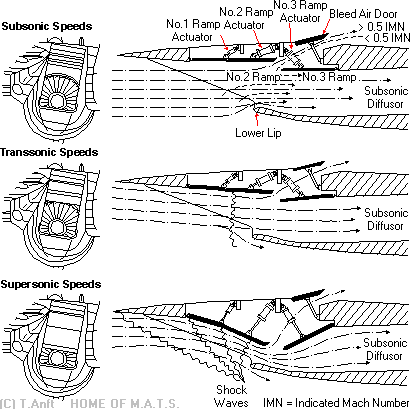You are using an out of date browser. It may not display this or other websites correctly.
You should upgrade or use an alternative browser.
You should upgrade or use an alternative browser.
J-10 Thread III (Closed to posting)
- Thread starter crobato
- Start date
- Status
- Not open for further replies.
MiG-29
Banned Idiot
A Good Article To Read (A Lot Of Useful Information)
J-10B compared with J-10A, overall there has been a noticeable change:
1, inlet becomes a DSI ("clam") inlet. J-10 for high-altitude high-speed performance, using a complex dual three-wave system can be paged in the airway, weight increased. DSI is the latest in technology, he applied in the United States on the latest F-35. Compared with the conventional intake, DSI canceled insulating layers, greatly reduces the weight. United States on F-16 test results show that DSI than complex intake reduces 182KG. Total pressure recovery factor is important indicator of intake, decline in total number of Restorer line 1%, engine thrust down 1.1%~1.6%. DSI is conducive to raising inlet total pressure recovery factor, improving the actual thrust of the engine. These two advantages make push than the effective promotion of J-10B. Another large benefit of DSI is separated boundary layer road was canceled this radar source, significantly reduced RCS. In addition, DSI can reduce costs, improve reliability.
Previously there were claims that DSI rather poor high speed performance. United States and the F-16 tests, the DSI when 0.6-1.2MH, total pressure recovery factor 0.98 per cent, but in 2.0MH, just 0.74 per cent. Because there are fears that DSI used can significantly reduce the J-10 of high-altitude high-speed performance. This worry is unnecessary, technology is always in development. Test results of a certain type of intake in China is, in 1.8MH total pressure recovery factor to 0.91, at the time of 2.0MH to 0.87, better than the General three-wave system inlet.
J-10 inlet becomes a DSI ("clam") inlet.
..
DSI has the advantages of eliminating many moving parts, thus reducing the amount of RAM, but comes with the disadvantage of limited speeds, a DSI will work efficiently up to Mach 1.7 but afterwards will increase pressure recovery losses, thus at Mach 2.2 the loses will risk the engine functioning and after Mach 1.7 the engine does not yield its max thrust.
a DSI only can generate 2 shocks as the intake of an F-16 or a Rafale that are fixed geometry intakes, an F-14 can generate 4 shocks thus it can fly at Mach 2.34 perfectly


The J-10B won`t fly better than the original version with variable geometry multishock engine, if you look at the graphs the J-10 will have loses of 15% or more after Mach 1.5, in order to achieve small loses you need to increase the shocks, an F-14 by generating 4 shocks has almost no lose, 87% at Mach 2 is a very large lose, in fact the author is simply saying the Al-31 very likely will have loses in thrust up to 15-20% at Mach 2.
So it is very unlikely it will reach Mach 2.2 as a Mirage 2000 or Mach 2.35 as a MiG-29.
The J-10B very likely is a Mach 1.7 fighter and fully loaded it won`t pass that speed.
Last edited:
Yano, not all bump and inlet geometries are the same.DSI has the advantages of eliminating many moving parts, thus reducing the amount of RAM, but comes with the disadvantage of limited speeds, a DSI will work efficiently up to Mach 1.7 but afterwards will increase pressure recovery losses, thus at Mach 2.2 the loses will risk the engine functioning and after Mach 1.7 the engine does not yield its max thrust.
a DSI only can generate 2 shocks as the intake of an F-16 or a Rafale that are fixed geometry intakes, an F-14 can generate 4 shocks thus it can fly at Mach 2.34 perfectly


The J-10B won`t fly better than the original version with variable geometry multishock engine, if you look at the graphs the J-10 will have loses of 15% or more after Mach 1.5, in order to achieve small loses you need to increase the shocks, an F-14 by generating 4 shocks has almost no lose, 87% at Mach 2 is a very large lose, in fact the author is simply saying the Al-31 very likely will have loses in thrust up to 15-20% at Mach 2.
So it is very unlikely it will reach Mach 2.2 as a Mirage 2000 or Mach 2.35 as a MiG-29.
The J-10B very likely is a Mach 1.7 fighter and fully loaded it won`t pass that speed.
MiG-29
Banned Idiot
that's right Mig-29, they make the J-10B go slower instead of faster than the original J-10
In this paper the computed flow and performance characteristics at
low angle-of-attack (AOA) of an integrated diverterless supersonic
inlet (DSI) are presented. The subsonic characteristics are evaluated
at M∞ = 0.8 while the supersonic characteristics are evaluated at M∞
= 1.7, which is near the design Mach number for the intake
further more
The ventral
DSI experimental investigation on a model configuration has been
reported by Xie(6,7) with detailed pressure and flow distortion results
that indicate maximum pressure recovery around M∞ = 1 that is
generally insensitive to moderate variation in angle of attack and
side slip angle.
Last edited:
MiG-29
Banned Idiot
read the paper do not speculate a DSI will do its best at Mach 1.6.Yano, not all bump and inlet geometries are the same.
what does the paper have to do with J-10B's intake?
or let me rephrase, is the intake design in that paper similar/identical to J-10B's?
a nice paper though, thanks
read this again :
or let me rephrase, is the intake design in that paper similar/identical to J-10B's?
a nice paper though, thanks
read this again :
Yano, not all bump and inlet geometries are the same.
- Status
- Not open for further replies.


